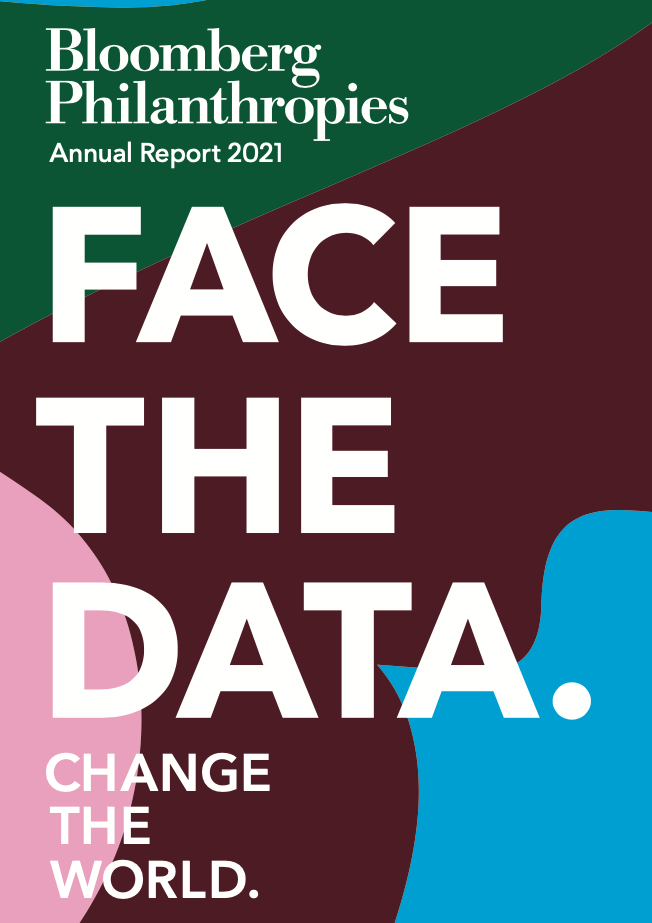
Annual Report 2021:
Letter on Philanthropy
Michael R. Bloomberg
“Today’s crisis always obscures tomorrow’s catastrophe. The more time, energy, and resources we devote to clear and present dangers, the more likely we are to allow emergencies in the making to go unchecked.”
Annual Report / Annual Letter on Philanthropy
It can be hard to look beyond the tip of your nose when you’re constantly peering at a swab going into it. But today’s crisis always obscures tomorrow’s catastrophe. The more time, energy, and resources we devote to clear and present dangers, the more likely we are to allow emergencies in the making to go unchecked.
As 2021 began, I was determined to avoid that trap, and so even as our foundation continued to expand our work helping countries and communities respond to and rebound from the pandemic, we also did something else: We stepped back and looked ahead – not to the next variant that might emerge, but to the next decade, and the next generation.
As we undertook this exercise, there was a certain “déjà vu all over again” feeling, as a great New Yorker once said, because 2021 marked the 20th anniversary of the September 11th terrorist attacks. I was elected mayor of New York City two months after the attacks, and back then, nearly all public attention centered on the immediate challenge of recovering and rebuilding, for understandable reasons. But our team in City Hall looked ahead and identified other looming threats, like the potential breakdown of our aging water tunnels and the emerging dangers of climate change, as well as an economy overly dependent on the fortunes of Wall Street and a school system that had been mired in dysfunction for decades. In each case and others, we made long-term investments that are still paying off today.
While the terrorist attacks presented a very different situation from the pandemic, our administration’s experience in City Hall helped shape the way our foundation approached 2021 and beyond, and it led us to launch a variety of major new long-term initiatives that you’ll read about in this report. That includes global expansions of existing programs – like our work to end coal-fired power plants – and the creation of entirely new organizations, such as the centers we are creating at Johns Hopkins and Harvard to support cities and their leaders. Each center has a different focus – Harvard on leadership development and Hopkins on policy and program development – and we are excited to see the results each produces.
The biggest new investment to grow out of our long-term planning process emerged from an unfortunate reality: Remote schooling during the pandemic has been nothing short of a calamity. In the early part of 2021, after studies clearly showed school reopenings to be safe, and with vaccines available to teachers, I strongly advocated for a universal reopening of schools. But many states and districts remained virtual – and their students continued to fall further behind. The data shows that remote schooling has dealt a serious blow to student learning levels, with children in low-income communities suffering most.
I have long supported public education efforts in traditional schools, and we have seen some important progress in a variety of places. But nationally, the pandemic laid bare just how broken the system is. Before 2020, American students were already falling further and further behind their peers overseas – and about two-thirds weren’t even reading at grade level. Over the two years that followed, the situation became even more dire.
Today, two years after the murders of Breonna Taylor and George Floyd helped ignite overdue conversations about racial injustices of every kind, achievement gaps between Black and Hispanic and white and Asian students are unconscionably wide and getting worse. Yet many of the political leaders who rightly decry these gaps have opposed the very reform that, in places like New York, has proven most successful at closing them: charter schools.
Children’s skin color or family income should never determine their chances of getting a high-quality education. But for far too long, they have. And if we follow the same old prescriptions – tinkering around the edges of a broken system and pouring more money into failing and mediocre schools without making fundamental change – we will fail another generation of students and perpetuate the historic injustices that continue to hold our country back.
After 20 years of working to improve public education, I have concluded that we need to be far more aggressive in rebuilding the system from outside traditional limits – without being hemmed in by decades of bureaucratic stasis and labor contracts that have strangled innovation, excellence, and accountability. That idea – rethinking the ways schools are run from scratch – lies at the heart of the charter school movement.
Public schools with charters allowing them to run independently of many restrictions can liberate principals and teachers to create learning environments that are both more nurturing and more demanding. In exchange for the freedom and flexibility to manage their classrooms, charter schools are required to hold everyone – including students – accountable for success. If they fail to succeed, they lose their charter – at least that’s the way it works in states with strong laws. Unlike with traditional schools, failure is not tolerated.
In many states, charter schools can set the length of their school year and school day. They can set their teachers’ salaries – allowing them to pay their high-performing and hardest-working teachers more. They can establish extra tutoring sessions for students most in need. And they can create cultures of excellence where struggling teachers are given help – and if they do not improve, they are not entitled to lifetime employment. Great teachers often choose to work in public charter schools because of high expectations that the schools establish for both students and teachers. Passion breeds success, and success is contagious.
Many charter schools are delivering extraordinary results that are reducing and even eliminating racial and ethnic achievement gaps. In some cases, low-income students in cities are out-performing their peers in the wealthiest suburbs – proving that success is possible, if children are given the schools they deserve.
Yet there are long waiting lists for public charter schools across the country. Many mayors and governors would like to expand charters, but they aren’t getting the financial support they need from Congress and the White House to do so. So, we’re going to help them.
Over the next five years, we will help turbocharge the charter school movement with a $750 million effort to create 150,000 new classroom seats in 20 metro areas. One of those areas will be New York City, where the election of a new mayor who is supportive of charter schools, Eric Adams, helped convince us that the time was right.
In City Hall, our administration created more than 165 new charter schools that serve predominantly Black and Hispanic communities that long lacked access to high-quality schools. One of the charter networks we helped create, Success Academy, has become the highest-performing group of schools – charter or district – in New York State. Now, to help it continue growing, we’ll fund construction of a new K-12 campus in the South Bronx with seats for 2,400 more students.
The 300,000-square-foot campus, which Bloomberg Philanthropies is supporting with $100 million, will be the largest privately financed public school in New York City history – with classrooms, laboratories, studios, and collaborative workspaces. The young scholars will come from the city’s poorest families and receive an education that will rival the most elite private schools. They will have science five days a week starting in kindergarten, something I could only dream about as a child who spent his Saturdays at the Boston Museum of Science. The high school will offer 10 advanced placement courses, with classes in bioengineering, computer science, creative writing, and the arts. And most importantly, the school will foster a culture of excellence where students learn to work hard, develop their natural talents, and raise their ambitions.
In addition to the new South Bronx campus, we’ll work in diverse metropolitan areas around the country to help local education leaders build and expand high-quality charter schools. As part of that work, we will join forces with the United Negro College Fund to increase the number of Black teachers and principals in high-quality charters across the South – and to involve Historically Black Colleges and Universities more directly in the formation and development of southern charter schools. This work will help build stronger pipelines between charters and HBCUs that have had such extraordinary success preparing their graduates to become leaders in their professions, expanding the Black middle class, tackling the racial wealth gap, and righting the wrongs of the past – goals that our new initiative is also strongly committed to.
In the year ahead, Bloomberg Philanthropies will remain committed to helping countries and communities rebound from the pandemic. At the same time, we will continue looking further down the road, taking on challenges that can’t wait – and helping people who need it most.
Sincerely,

Michael R. Bloomberg
Founder
Bloomberg Philanthropies
Connect with Mike Bloomberg on Twitter, Facebook, Instagram, and LinkedIn.
